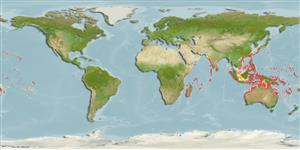Actinopterygii (ray-finned fishes) >
Perciformes (Perch-likes) >
Gobiidae (Gobies) > Gobiinae
Etymology: Valenciennea: From Achille Valenciennes 1794-1865; he worked with Duméril, Cuvier and Lacepède since 1815; malacologist, author of a "Histoire naturelle des poissons" (Ref. 45335).
Environment / Climate / Range
Ecology
Marine; reef-associated; depth range 1 - 45 m (Ref. 48637), usually 1 - 30 m (Ref. 27115). Tropical; 22°C - 27°C (Ref. 27115), preferred ?; 44°N - 29°S, 32°E - 138°W
Indo-West Pacific: southern Red Sea (Ref. 34105) and East Africa (where common, Ref. 9710) to Indonesia, north to southern Japan (Ref. 9710), south to the Great Barrier Reef (Ref. 2334).
Size / Weight / Age
Maturity: Lm ? range ? - ? cm
Max length : 25.0 cm TL male/unsexed; (Ref. 9002); common length : 18.0 cm TL male/unsexed; (Ref. 9002)
Dorsal
spines
(total): 7;
Dorsal
soft rays
(total): 11;
Anal
spines: 1;
Anal
soft rays: 11. Characterized by pale grey body color with broad white midlateral stripe bordered by pair of black to brownish stripes; first dorsal fin with large black spot; truncate to slightly emarginate caudal fin, ray above and below central three rays prolonged as filament in adult; length of caudal fin 2.4-5.0 in SL; longitudinal scale series 127-146; ctenoid body scales except cycloid on abdomen; head or midline of nape without scales; in adult, cycloid scales extending forward on side of nape to above middle of operculum; base of pectoral fin and prepelvic area scaled in adult; depth of body 5.0 in SL (Ref. 90102).
A relatively rare species occurring singly but usually in pairs over silty flat sand patches, or rubble substrates; a mound-building species. Usually found on outer reefs at the bottom of coral or rocky drop-offs, rarely in lagoons. Feeds on small burrowing animals by sifting mouthfuls of sand. Monogamous (Ref. 34105, 48637, 52884). Eggs hatched 2 days after spawning in aquaria; 35 days after, the larvae reached 5.25 mm.
Life cycle and mating behavior
Maturity | Reproduction | Spawning | Eggs | Fecundity | Larvae
Hoese, D.F. and H.K. Larson, 1994. Revision of the Indo-Pacific gobiid fish genus Valenciennea, with descriptions of seven new species. Indo-Pac. Fish. (23):71 p. (Ref. 8527)
IUCN Red List Status (Ref. 115185)
CITES (Ref. 94142)
Not Evaluated
Threat to humans
Harmless
Human uses
Aquarium: commercial
More information
Common namesSynonymsMetabolismPredatorsEcotoxicologyReproductionMaturitySpawningFecundityEggsEgg development
ReferencesAquacultureAquaculture profileStrainsGeneticsAllele frequenciesHeritabilityDiseasesProcessingMass conversion
Tools
Special reports
Download XML
Internet sources
